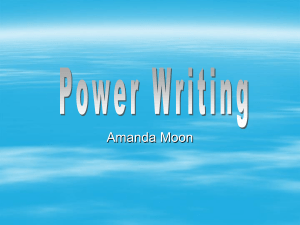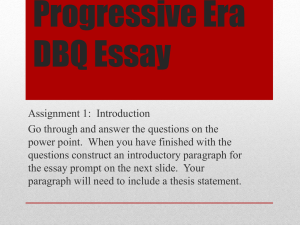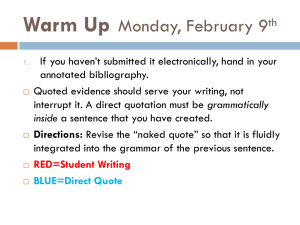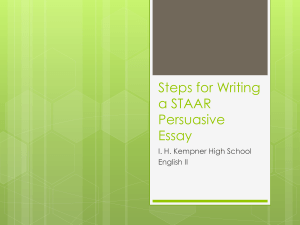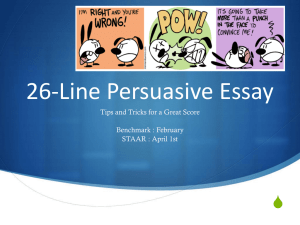An Introduction to the Introduction
advertisement
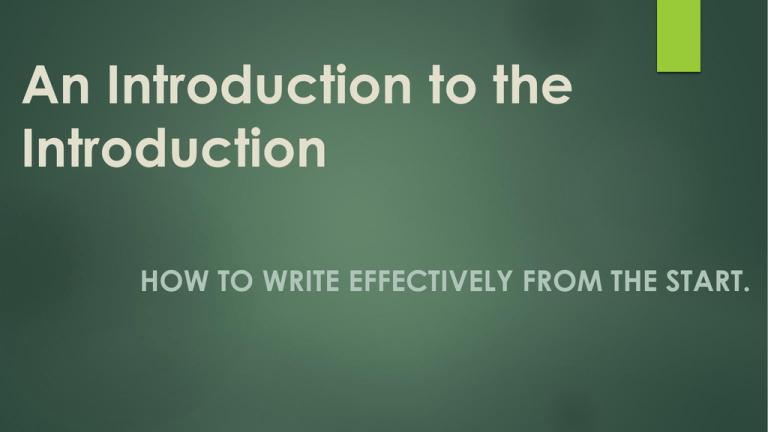
An Introduction to the Introduction HOW TO WRITE EFFECTIVELY FROM THE START. The Hook Your opening sentence(s) should hook the reader’s attention. a.k.a. Lure Do grabber/lead sentence in your audience. NOT give away the specifics of your topic. Types of Hooks No “one size fits all” formula. What works best for you, the purpose of the prompt, and for your audience? Types of Hooks 1. Imagine Statement: “Ask” the reader to picture or imagine a scenario that will be addressed later. EXAMPLE: Prompt: If you could change one thing about your school, what would it be? Imagine Statement: Imagine a classroom full of eager students who are ready to learn and quiet as mice. This could happen if we were only allowed to have free time. Now, You Try… Prompt: Why is it so important to follow school rules? Hook: ? Or Prompt: If you were a professional athlete, which sport would you play and why? Hook: ? Types of Hooks 2. Dialogue: Open with dialogue. Must use quotation marks and proper punctuation. EXAMPLE: Prompt: Write about a traumatic event that has happened in your life. Dialogue: “Get out of the house, now!” Dad screamed as the blazing fire rushed toward us. Now, You Try… Prompt: If you could change one thing about yourself, what would it be and why? Hook: ? Or Prompt: If you were turned into a teacher for one day, what would you do? Hook: ? Types of Hooks 3. The Riddle: Open with a riddle for the reader to solve. EXAMPLE: Prompt: Write about a time you were influenced by peer pressure. The Riddle: What can sneak up on you, influence you greatly, and get you into trouble? I will never forget the time my supposed friends pushed me to do something I never should have done. Now, You Try… Prompt: Tell about a time when you forgot to do something very important. Hook: ? Or Prompt: You have been asked to plan an afterschool program for your school. Think about activities that students might enjoy. Write about this after-school program. Hook: ? Types of Hooks 4. Famous Quote: Begin with a well-known (or not-so-well-known) quote. From a book, song, person, etc. EXAMPLE: Prompt: If you could change one thing about yourself, what would it be and why? Famous Quote: As Thoreau once said, “It’s not what you look at that matters. It’s what you see.” When I look in the mirror, I see just another human being, one with a major physical flaw... Now, You Try… Prompt: You just found out that the world will end in three days. Explain how you would spend the remainder of your time on earth? Hook: ? OR Prompt: Everyone has experienced fear at one point in their lives. Think about a time when you were afraid. Explain why this was such a fearful event. Hook: ? Types of Hooks 5. Imagery: (Sensory Language) Description of a place or situation. Appeals to the five senses. Can be purposeful fragments. EXAMPLE: Prompt: Write about the best family vacation ever. Imagery: Sitting silently on the crowded beach, listening to the echoes of seagulls screeching overhead, I remember breathing in the salty, coconut air. Now, You Try… Prompt: Why should students have free time at school? Hook: ? OR Prompt: Whether young or old, everyone has imagined their own version of an ideal day. Think about what you would do. Explain why this would be your perfect day. Hook: ? Types of Hooks Brief Anecdote: Begin with a quick story or personal experience relating to the topic. Two-three sentences. EXAMPLE: Prompt: There have been many inventions that have impacted the world. What has been the most beneficial invention? Explain why. Anecdote: When I was in middle school, nothing brought more happiness to my life than music. Just relaxing on my bed, letting my mind freely flow to the vibes of Bob Marley, I was content. However, this satisfaction would not be fulfilled without the iPod. 6. Now, You Try… Prompt: Hook: Who is your hero? Why? ? OR Prompt: There have been many inventions that have impacted the world. What has been the most beneficial invention? Explain why. Hook: ? Thesis Statement: Reveals the two OR three main points of your paper. Usually combined into a single, complex sentence. Usually the last sentence(s) of your introduction. A “road map” for your reader. 1st point = 1st body paragraph 2nd point = 2nd body paragraph 3rd point = 3rd body paragraph Example Prompt: Eating healthy foods is important. Explain why you should eat healthy foods. Thesis Statement: Without a doubt, maintaining a nutritious diet is highly beneficial, increasing energy levels, enhancing one’s physique, and most importantly, preventing potential illness. st 1 body paragraph = energy 2nd body paragraph = physique 3rd body paragraph = illness prevention Example (Together) Prompt: Explain the potential benefits of attending college. Brainstorm What possible points. are some potential benefits? What works best for you, your purpose, and your audience? Thesis Statement: ? Now, You Try… Prompt: If you could be a famous person, who would you be, and why? Thesis Statement: ? OR What is your favorite means of transportation? Explain why. Prompt: Thesis Statement: ? Thus, the Introductory Paragraph… Hook + Thesis Statement = Introductory Paragraph You may need a transitional word, phrase, or sentence to connect your hook and thesis statement. Now, You Try… Instructions: 1. Select one of the previous prompts. 2. From that prompt, choose the most suitable type of hook. 3. Lure in the audience. 4. Brainstorm possible points to create a thesis statement. 5. Connect your hook and your thesis statement. 6. Now, you have written an introductory paragraph. Peer Review After writing your introductory paragraph, share with THREE of your peers for constructive feedback. On a sticky note, peers will identify the following: Type of hook used, rating effectiveness on a scale of 1-4 2. Two-three points of thesis statement, rating effectiveness on a scale of 1-4 3. One positive, one negative comment (Be constructive!) 4. Sign your name as well. 1.
